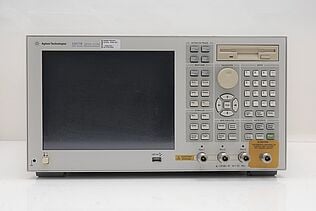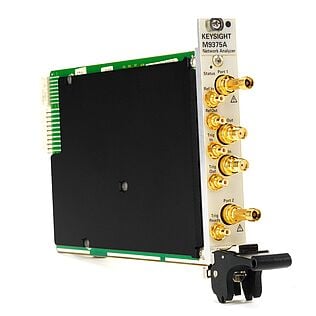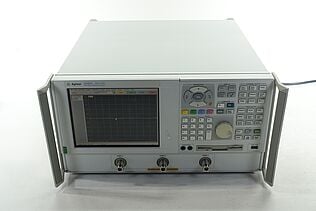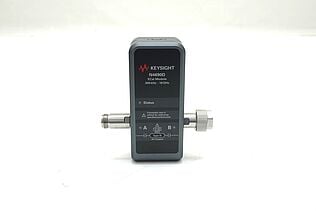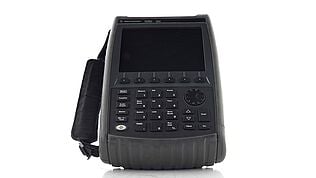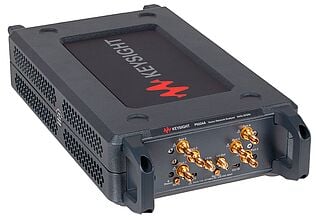- Introduction
- All About Network Analyzers
- What is a Network Analyzer?
- Types of Network Analyzers
- What Are Network Analyzers Used For?
- Network Analyzer Specs
- All About Spectrum Analyzers
- What Is a Spectrum Analyzer?
- Types of Spectrum Analyzers
- What are Spectrum Analyzers Used For?
- Spectrum Analyzer Specs
- Spectrum vs Network Analyzers: Key Differences
- Choose the Perfect Analyzer for Your Needs!
- Closing Thoughts From Keysight
Engineers today face many choices when selecting the right analysis tool for their needs. This can be complicated considering the vast amount of tool types and manufacturers in the market. Finding the right piece of equipment can take a lot of time and effort, especially when some can be quite similar.
Two common options are network and spectrum analyzers, but what’s the difference between them? And how can you know which one is right for your application? In this article, we’ll explore the key distinctions between these two types of analyzers so you can make an informed decision about which one is right for your application.
All About Network Analyzers
In this section, we'll delve into everything you need to know about network analyzers. This will include the different types of analyzers, a description of their function, what they are used for, some key features and how they are used.

What is a Network Analyzer?
A network analyzer is an instrument that measures the network parameters of electrical circuits. Network analyzers mostly measure S-parameters, which are a type of parameter that characterizes the electrical behavior of linear circuits, or more specifically, the input/output relationships of circuits between ports.
Network analyzers can also measure Y-parameters, Z-parameters, and H-parameters. These parameters are used to characterize the electrical behavior of nonlinear circuits. By measuring these parameters, network analyzers can help engineers understand how their circuits will behave under different conditions.
They are also used to improve and optimize the performance of circuits by measuring parameters like gain, return loss, and impedance. Network analyzers use a technique called power measurement to determine the power of a signal. They also use frequency sweep to measure the frequency response of a circuit. When measuring impedance, they can utilize Time Domain Reflectometry (TDR), a specialized form of time domain analysis.
Network analyzers come in handheld devices, benchtop units, and modular units. They are available in different form factors, such as 2-port, 4-port, and 8-port analyzers.
Types of Network Analyzers
There are three main network analyzers:
- Vector network analyzers (VNAs)
- Scalar network analyzers (SNAs)
- Large-signal network analyzers
VNAs are the most common type of network analyzer on the market today. They offer several advantages, including the ability to simultaneously measure all four S-parameters and support a wide range of frequencies, which makes them ideal for a number of applications. An SNA only measures the amplitude properties of the circuit. Large-signal network analyzers are less common than VNAs and SNAs, but they offer the advantage of measuring nonlinear circuits, which means they can be used in a wider range of applications.

What Are Network Analyzers Used For?
Network analyzers are used for various purposes, including measuring the performance of circuits, debugging circuits, and characterizing circuits. They can also be used to calibrate other instruments. Network analyzers are commonly used in the telecommunications industry, the aerospace industry, and the automotive industry.
Some common uses for network analyzers are:
- High-frequency measurements. Network analyzers are used for the high-frequency response of a circuit. By doing this, they can help engineers understand how their circuits behave under different conditions. They can also be used to improve the performance of circuits by identifying any issues that may occur at high frequencies.
- Transmission and reflection measurements. This describes how a signal travels through a medium. Network analyzers can be used to measure the transmission and reflection of signals so that engineers can understand how their circuits will behave.
- Characterization of a two-port network. Network analyzers can be used to characterize a two-port network. This is done by measuring the S-parameters of the network. The S-parameters are a set of four parameters that describe the electrical behavior of a circuit. By measuring the S-parameters, network analyzers can help engineers understand how their circuits will behave under different conditions.
- Other RF-based measurements. Network analyzers can also be used for other RF-based measurements. These measurements include gain, return loss, and noise figure.
When choosing the best network analyzer, it is important to consider the type of analyzer and the frequency range that you need, as well as your budget. There are many different manufacturers that offer network analyzers, so it is important to compare the features and specifications of each one to find the best fit for your needs.
Now that we have looked into what network analyzers are used for let's look at some more specifications.
Network Analyzer Specs
There are many specifications you need to be aware of when shopping for a network analyzer. These specifications include:
| Specification | Description |
|---|---|
| Frequency range | The range of frequencies that the network analyzer can measure. The frequency range determines the application you can use the network analyzer for. |
| Dynamic range | This is the ratio between the largest signal that the network analyzer can measure and the smallest signal that the network analyzer can measure. |
| Output power | This is the power level that the network analyzer can output. It is important to know how much power the network analyzer can effectively provide to your circuit. |
| Accuracy | The degree to which the measurements made by the network analyzer match the actual values of the signals being measured. |
| Precision | The degree to which repeated measurements made by the network analyzer match each other. |
| Bandwidth | The range of frequencies over which the network analyzer can make measurements. |
| Noise | The noise specification is the signal-to-noise ratio. This compares the noise of the signal to background noise. |
| Sweep time | This is the amount of time it takes the network analyzer to make one measurement. |
| Number of ports | The number of ports is the number of connections that the network analyzer has. |
As the table shows, there are many key specifications that you need to be aware of before you purchase a network analyzer. Let's now take a look at spectrum analyzers.
All About Spectrum Analyzers
In this next section, we will learn about spectrum analyzers or (signal analyzers). We will start by looking at what they are, their specifications, and the different types on the market. By the end, you should have a good understanding of what spectrum analyzers are and their various applications.

What Is a Spectrum Analyzer?
A spectrum analyzer is a device used to measure a signal's strength over a range of frequencies. The spectrum analyzer will generate a graph showing the signal amplitude at each frequency. This means that it will show what frequencies are present in the signal and how much power each frequency carries. The frequency is shown on a linear scale (horizontal (X) axis), and the amplitude is displayed on the vertical (Y) axis. This information can be used to troubleshoot problems with circuits, optimize performance, and more.
Spectrum analyzers are receivers that display the radio frequency (RF) signal, which can be used to detect and find problems with the signal. They are handy for this purpose as they can help you to find the source of interference, optimize the performance of your system, and more. They are most commonly used in the field of radio and telecommunications for analyzing and troubleshooting signal problems.
Some real-world uses of spectrum analyzers include:
- Finding the source of interference in a radio system
- Identifying the cause of signal degradation
- Optimizing the performance of a radio system
- Detecting faults in equipment
- Analyzing the behavior of digital systems

Types of Spectrum Analyzers
There are multiple types of spectrum analyzers, and the type will vary depending on the application and what you need. For example, there are handheld spectrum analyzers, which are portable and easy to use. There are also benchtop spectrum analyzers, which are larger and more expensive but offer more features and higher performance.
Let's look at the three main types:
- Fast Fourier transforms spectrum analyzer. These analyzers take a signal and break it down into its component frequencies. This allows you to see all of the frequencies present in the signal and their amplitudes.
- Real-time spectrum analyzers. These measure the signal continuously and provide a live view of the signal. This makes them very useful for monitoring purposes as you can see what is happening in real-time.
- Superheterodyne spectrum analyzers. These are the most common type of spectrum analyzers. They mix the input signal with a local oscillator to create an intermediate frequency (IF) signal. This signal is then amplified and filtered before being sent to the display.
The type of analyzer you will need depends on the application. For example, if you are looking for interference of a signal, a real-time analyzer would be the best choice. If you need to see the entire spectrum of frequencies, a fast Fourier transform analyzer would be the best option.
That summarizes the main types of spectrum analyzers, let's now dive into their applications.
What are Spectrum Analyzers Used For?
Spectrum analyzers have a range of uses, and they are used in many industries. They can be used for troubleshooting, optimizing performance, measuring signals, and more.
Some of the common uses of spectrum analyzers include:
- Signal frequency measurements. This is one of the most common uses for spectrum analyzers. They can measure the frequency of a signal so that you can optimize the performance of your system.
- Signal troubleshooting. If you are having problems with a weak signal, a spectrum analyzer can be used to find the source of the problem. This is done by analyzing the frequency of a signal and trying to find where the problem is. This is very helpful in troubleshooting and fixing issues for a wide range of applications like WiFi, cellular signals, and more.
- Frequency measurements. Another common use for spectrum analyzers is measuring the frequency of a signal. This can be used to find the center frequency of a signal or to measure the bandwidth, which is particularly helpful in radio applications.
- Phase noise measurements. Spectrum analyzers can also be used to measure the phase noise of a signal. This is the amount of noise (or interference) present in a signal at a certain frequency domain. Once you see this, you can work to minimize the phase noise to improve the quality of your signal.
- Intermodulation distortion measurements. (IMD) is when two or more signals mix and create new frequencies that were not originally present. This can be problematic for many applications.

As you can see, spectrum analyzers have a wide range of uses. Along with the uses mentioned above, spectrum analyzers have other common applications, such as testing electronic filter circuits. For example, a filter circuit may be designed to pass signals in a certain frequency range and block others. A spectrum analyzer can test the filter and see if it is working as intended.
Spectrum Analyzer Specs
There are many different features and specs that you may want to consider, but here are some of the most important ones:
- Frequency range: The range of frequencies that a spectrum analyzer can measure. You will want to ensure that the chosen analyzer can measure your frequencies of interest.
- Dynamic range: The difference between the largest and smallest signal that a spectrum analyzer can measure.
- Noise: The amount of interference that is present in a signal. The lower the noise level, the better.
- Bandwidth: The range of frequencies a spectrum analyzer can measure simultaneously. It is important to consider the bandwidth because it will affect the resolution of your measurements. Higher bandwidth will allow you to see more detail, but it will also be more expensive.
- Resolution: The smallest difference in frequency that a spectrum analyzer can measure. This is an important spec to consider because it will affect the level of detail of your measurements.
- Display type: There are two main types of displays for spectrum analyzers: analog and digital. Analog displays are cheaper but not as accurate as digital displays.
- Input type: There are two main types of inputs for spectrum analyzers: coaxial and optical. Coaxial inputs are the most common, but optical inputs are becoming more popular because they offer better performance.
These are just a few of the most important specs to consider when choosing a spectrum analyzer. When choosing a spectrum analyzer, it is important to consider your needs and budget since many different models are available.
Spectrum vs Network Analyzers: Key Differences
Although spectrum and network analyzers may seem similar, there are some key differences to keep in mind. The table below shows how they differ in both specifications and application.
| Spectrum Analyzer | Network Analyzer |
|---|---|
| Used to measure the amplitude and frequency of a signal | Used to measure the S-parameters within an electrical network |
| Has a wider frequency range | Has smaller frequency range |
| Has lower accuracy in measurements | Provides higher levels of accuracy |
| Limited calibration capacities | Advanced calibration capacities |
| More susceptible to noise interference | Less susceptible to noise interference |
| Has no error correction | Offers advanced error correction |
| Are receivers only (with one channel) | Has both a receiver and a source (multiple channels) |
When it comes to choosing an analyzer, it is essential to consider what you need. If you need to measure signals outside the range of frequencies used by networks, you will need a spectrum analyzer. If you need to troubleshoot other network problems, you will need a network analyzer.
Choose the Perfect Analyzer for Your Needs!
To get reliable results, you need an analyzer that you can trust. We know choosing a suitable analyzer can be overwhelming. But it doesn't need to be. At Keysight, we specialize in helping to find the right analyzer to fit your needs and budget. If you are looking for network analyzers trusted by over 70% of engineering teams worldwide, check out our options here.
Or, if you are looking for a spectrum analyzer that offers results you can trust every time, we have you covered.
Closing Thoughts From Keysight
As we have looked at, choosing the right analyzer is important and the one you choose to purchase will depend on what kind of signals you need to measure. Network and spectrum analyzers are both exceptional tools for measuring different aspects of electronic signals. Before investing in the analyzer you need, remember:
- Network analyzers are used to measure the electrical properties of a network
- Spectrum analyzers are used to measure the signal amplitudes at different frequencies
No matter what type of analyzer you are looking for, Keysight can help you find the right one to fit your needs. We offer a wide range of used equipment, including spectrum and network analyzers trusted and used by engineers worldwide. For help finding the correct analyzer for your needs, contact us today.












